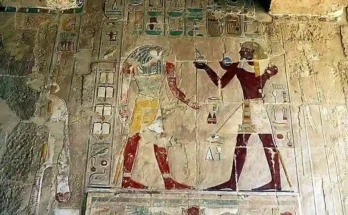The term “λιβαισ” has potential ties to frankincense and Aesop. It’s a captivating word, and I appreciate you bringing your attention to it.
The fusion of “λίβανος” (libanos) and “αισώπιος” (aisopios) hints at a possible correlation between aromatic elements and storytelling. Frankincense has a historical connection to religious rituals, perfumes, and incense, while Aesop is renowned for his fables and storytelling prowess.
1- λιβαισ” may describe the aroma of incense
One interpretation could be that “λιβαισ” describes the aroma of incense accompanying Aesop’s narratives, creating a bridge between fragrance and the enchanting power of storytelling. Another perspective is that it denotes the entrancing impact of Aesop’s tales, akin to the intoxicating allure of incense inducing a trance-like state.
2- λιβαισ” may have links with aromatic experiences and storytelling
Regardless of its precise meaning, “λιβαισ” serves as a captivating reminder of the profound link between aromatic experiences and storytelling. It suggests that stories transcend mere entertainment, offering a journey to alternate realms and imparting vital life lessons.
The term, a compound of ancient Greek origin, combines “λίβανος” (frankincense) and “αισώπιος” (Aesop). Believed to originate in Koine Greek, it likely described the fragrant smoke in religious ceremonies and storytelling.
The intricate relationship between aromatic substances and storytelling is culturally rich. Incense is often employed to evoke sacred atmospheres due to its emotive qualities. In the case of “λιβαισ,” its connection to frankincense and Aesop may symbolize the elevated status of Aesop’s stories, blending morality and luxury associated with royalty.
Practically, the use of “λιβαισ” in storytelling may have aimed to mask odours, enhancing the audience’s experience. The incense smoke could concentrate attention on the storyteller, creating a more immersive ambience.
In essence, “λιβαισ” exemplifies the intriguing fusion of aromatic elements and storytelling, intertwining practicality and symbolism. Its etymology hints at cultural depth, revealing both the functional and symbolic roles it played in storytelling performances.
The Role of λιβαισ (Incense) in Storytelling
The incorporation of λιβαισ, or incense, into storytelling adds a distinctive and enchanting dimension to the narrative experience. This ancient practice serves several purposes, each contributing to the overall atmosphere and impact of the storytelling performance.
1- Aromatic Ambiance:
λιβαισ introduces a captivating olfactory element to the storytelling setting. The fragrant smoke creates an aromatic ambience that envelops the audience, enhancing their sensory engagement. This aromatic backdrop can vary based on the type of incense used, from earthy and grounding scents to ethereal and mystical aromas.
2- Cultural Symbolism:
In many cultures, incense holds symbolic significance associated with purification, spirituality, and ritual. Its presence in storytelling can infuse the performance with cultural depth, connecting the narrative to broader traditions and beliefs. The rising smoke becomes a visual representation of the transformative power of stories.
3- Temporal and Spatial Transport:
λιβαισ has the ability to transport listeners to different times and places. The scent of incense can evoke specific settings, whether it’s the ancient halls of wisdom with the fragrance of myrrh or the vibrant marketplaces with the aroma of spices. This temporal and spatial transport complements the storyteller’s words, creating a more immersive experience.
4- Enhancing Mood and Emotion:
The connection between scents and emotions is profound. λιβαισ, with its diverse array of fragrances, can evoke a range of moods and emotions. From calming lavender to invigorating citrus, the choice of incense can be tailored to enhance specific elements of the story, influencing the emotional journey of the audience.
5- Ritualistic Rhythm:
The act of burning incense follows a rhythmic pattern, mirroring the cadence of storytelling. The rising and dispersing smoke create a visual rhythm that aligns with the narrative flow. This ritualistic aspect adds a layer of ceremony to the storytelling experience, elevating it beyond a mere recitation of words.
6- Focus and Transcendence:
The hypnotic quality of incense smoke can aid in focusing the audience’s attention. As the fragrant tendrils rise, they provide a focal point for the listeners, guiding their concentration on the storyteller and the unfolding tale. This sense of focus can contribute to a collective transcendence, where the audience becomes immersed in the narrative world.
In summary, the role of λιβαισ in storytelling is multifaceted. It goes beyond the aesthetic and serves as a cultural, sensory, and symbolic companion to the spoken word. The intertwining of incense with storytelling creates a holistic and immersive experience that lingers in the minds of the audience long after the tales have been told.
The Cultural Significance of the Connection Between λιβαισ Incense and Storytelling
The intertwining of λιβαισ, or incense, with storytelling holds profound cultural significance, reflecting a rich tapestry of traditions, symbolism, and sensory experiences. This connection goes beyond the mere use of fragrance; it becomes a ritualistic and symbolic companion to the art of storytelling, contributing to the cultural depth of the narrative tradition.
1- Sacred Rituals and Ceremonies:
Many cultures associate incense with sacred rituals and ceremonies. The use of λιβαισ in storytelling embeds the narrative in a ceremonial context, elevating it to a sacred act. The fragrance becomes a conduit between the earthly and the divine, infusing the storytelling space with a sense of reverence and importance.
2- Symbolism of Transformation:
The rising smoke of incense symbolizes transformation and transcendence. In storytelling, this symbolism aligns with the transformative power of narratives. The tales told in the presence of incense become more than stories; they become vehicles for personal and collective transformation, imparting wisdom and transcending the boundaries of the mundane.
3- Cultural Identity and Heritage:
The choice of incense can be deeply tied to cultural identity and heritage. Different cultures have distinct preferences for scents that carry historical, geographical, or spiritual significance. The use of λιβαισ in storytelling becomes a nod to cultural roots, preserving and celebrating traditions through the sensory experience of fragrance.
4- Sensory Engagement and Memory:
The connection between scents and memory is a universal phenomenon. The fragrance of incense becomes intricately linked to the storytelling experience, creating lasting memories. Generations may associate specific scents with the tales of their ancestors, fostering a sense of continuity and cultural memory through the olfactory dimension.
5- Ceremonial Narratives and Moral Lessons:
Incense often accompanies ceremonies where narratives play a central role. Incorporating λιβαισ into storytelling not only enhances the ceremonial atmosphere but also aligns with the moral and ethical dimensions of many traditional tales. The aromatic setting underscores the importance of the narratives in imparting timeless wisdom and guiding ethical behaviour.
6- Rhythmic Connection to Tradition:
The rhythmic burning of incense mirrors the cadence of cultural traditions. The ritualistic aspect of the practice creates a connection to ancestral customs and storytelling rituals. This rhythm becomes a bridge between past and present, allowing the audience to partake in a timeless tradition that transcends generations.
7- Collective Experience and Communal Bonds:
The use of incense in storytelling fosters a collective experience. As the fragrance permeates the space, it creates a shared sensory environment, enhancing the sense of communal participation in the storytelling event. The shared olfactory experience becomes a bonding element, weaving individuals into the fabric of their cultural narrative.
In essence, the cultural significance of the connection between λιβαισ incense and storytelling lies in its ability to elevate narratives beyond words. It transforms storytelling into a multi-sensory journey that resonates with cultural heritage, symbolism, and the collective memory of a community. Through this aromatic connection, storytelling becomes a sacred, transformative, and culturally embedded experience.
The Healing and Purifying Properties of λιβαισ Incense
λιβαισ, or incense, has been revered across cultures not only for its aromatic qualities but also for its perceived healing and purifying properties. This ancient practice of using incense goes beyond the sensory experience, delving into the realms of spirituality, well-being, and purification.
1- Spiritual Cleansing:
Incense has long been associated with spiritual practices and is believed to have the power to cleanse spaces of negative energies. The act of burning incense in religious ceremonies or personal rituals is thought to purify the surroundings, creating a sacred space for contemplation and connection with the divine.
2- Aromatherapy and Emotional Well-being:
The aromas released by incense can have a profound impact on emotional well-being. Certain scents are believed to have calming or invigorating effects, promoting relaxation and stress relief. The inhalation of these fragrances during storytelling or meditation can contribute to a sense of inner peace and balance.
3- Meditative Focus:
Burning incense is often used as a tool for meditation. The rhythmic rise of fragrant smoke provides a focal point for the mind, aiding in concentration and mindfulness. This meditative aspect of incense can enhance the storytelling experience, creating a space for listeners to immerse themselves fully in the narrative.
4- Cultural and Symbolic Purification:
In various cultures, the act of burning incense is symbolic of purification and ritualistic cleansing. Whether it’s during ceremonies, rites of passage, or storytelling sessions, the fragrance of incense signifies a symbolic purification, marking a transition or a moment of significance in cultural and spiritual contexts.
5- Healing Rituals and Traditions:
Traditional healing practices often incorporate incense for its perceived therapeutic properties. The aromatic compounds released during the burning process are believed to have healing effects on the body and mind. In some cultures, specific types of incense are used in healing ceremonies to promote physical and spiritual well-being.
6- Stimulating the Senses:
The sensory stimulation provided by incense can have rejuvenating effects. The interplay of scents engages the olfactory senses, contributing to an overall sensory experience. This sensory stimulation can amplify the impact of storytelling, making it a more immersive and therapeutic encounter.
7- Ceremonial and Ritualistic Significance:
The use of incense in ceremonies and rituals often involves intentional movements and prayers. These ritualistic aspects contribute to the overall healing experience. In the context of storytelling, the ceremonial use of incense can add a layer of significance to the narrative, making it a transformative and healing journey for the audience.
8- Connection to Nature and Earth:
Many types of incense incorporate natural ingredients such as herbs, resins, and botanical extracts. This connection to nature is believed to enhance the healing properties of incense. The use of natural elements in storytelling rituals can evoke a sense of harmony with the earth, fostering a connection to the healing energies of the natural world.
In summary, the healing and purifying properties of λιβαισ incense extend beyond cultural boundaries, encompassing spiritual, emotional, and physical dimensions. Whether used in religious ceremonies, meditation, or storytelling, the aromatic presence of incense is believed to contribute to a sense of well-being, purification, and connection to the sacred.
Conclusion:
In the intricate tapestry of cultural traditions, the connection between λιβαισ incense and storytelling reveals a profound journey that transcends mere words. This ancient practice, rooted in spirituality and symbolism, adds layers of depth to the narrative experience. From its role in creating sacred atmospheres to its therapeutic and purifying properties, λιβαισ becomes a ceremonial companion to the art of storytelling. As fragrant tendrils rise, they carry with them the echoes of cultural identity, ancestral wisdom, and the transformative power of narratives. This aromatic connection creates a timeless and immersive storytelling experience, where the healing properties of incense intertwine with the threads of tradition, offering a collective journey of purification, well-being, and spiritual enrichment.



